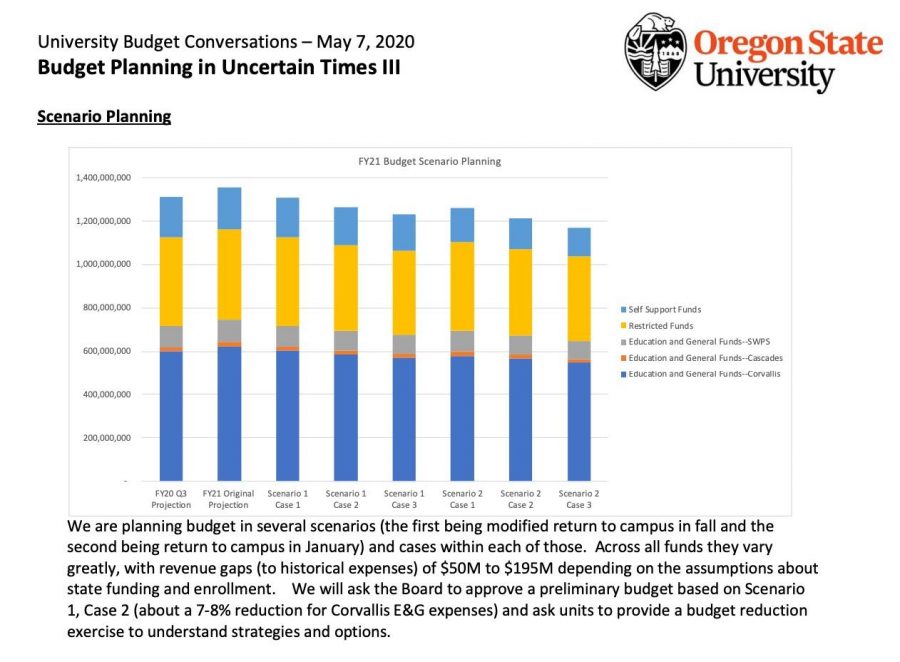University Budget Committee plans for uncertainty, financial challenges facing OSU
May 11, 2020
Oregon State University’s University Budget Committee met to discuss budget planning on Friday, May 8, as OSU and higher education institutions across the nation face uncertainty and financial challenges as a result of the COVID-19 pandemic.
Sherm Bloomer, the associate vice president of Budget and Resource Planning, began the meeting by providing the UBC panel with an overview of the national issues facing higher education.
“I don’t mean this as an incredible downer—this is a national challenge right now. Everybody is struggling with this. Every public university is struggling with this. The degree is different, but we’re not alone in what we’re looking at,” Bloomer said during Friday’s meeting.
Bloomer shared a graph outlining different budget scenarios that could possibly occur depending on the mode of instruction in the fall, or if the university faces drops in enrollment. Bloomer said OSU is still working through whether furloughs or salary reductions will be issued, and that it will largely depend on how big a budget hole the university will have to fill.
“The budget will depend on how large a reduction the state makes and how enrollment is. We likely won’t know about the state until May, and enrollment possibly not until early September,” Bloomer said via email. “So until we have a better idea on those, it is hard to estimate when or how.”
Vice Provost of Enrollment Management Jon Boeckenstedt said there is no way to guess or model what enrollment will look like for fall this early in the year since the current situation is “completely unprecedented.”
“Someone who’s paid a deposit today probably has a lower propensity to end up enrolling than someone who paid a deposit last year on this date. So, we just don’t know. There’s no way to model this, no way to guess,” Boeckenstedt said in Friday’s meeting. “I’ve told people that once we figure out what the pandemic is going to do, then we can figure out what our instructional mode will be, and once we figure out what our instructional mode will be, we’ll talk to students, and then they can make their decision after they talk to parents and other people about whether they can afford it. There are so many different routes you can follow with the combination and permutation of all those factors that it’s just not possible to make any accurate prediction.”
Allison Hurst, associate professor of sociology and a UBC faculty member, said constructing budgets is always difficult, but is particularly difficult this year, given how uncertain the future is.
“It seems highly unlikely that OSU will be able to weather this storm without spending much less next year than they need to spend, to keep things going as they have been. So how do you do this? Cutting instructors is a little like shooting yourself in the foot, as our instructors are what makes us a university in the first place. Students come to OSU to learn, so we need teachers,” Hurst said via email. “If we have less money, how do we pay for instruction? One option is a collective (temporary) pay cut. I would feel better about that than dismissing instructors and then increasing the workload for those remaining. But we need details on how that would work—how it could be done fairly (progressively, so that those with the lowest pay are not harmed more than those that can more readily afford a pay cut).”
Bloomer said budget reduction planning guidelines will go out to units across the university on May 11 in order to begin planning what choices they have and what they will prioritize, should cuts be made.
“From that, we will talk about what makes sense across the university as a whole,” Bloomer said via email. “Actual reductions come when a unit is given a final budget and has to make whatever expense reductions are required to fit inside that budget. We are not at that point yet.”
Overall, Bloomer said the university is trying not to rush any decisions.
“I think everyone at every level is working as hard as they can to reopen the university and have students and faculty back in labs and classrooms for fall, safely and in coordination with state and local health authorities,” Bloomer said via email. “There’s a lot of uncertainty, but I’ve been inspired by the work of all the faculty and staff.”

















































































![Newspaper clipping from February 25, 1970 in the Daily Barometer showing an article written by Bob Allen, past Barometer Editor. This article was written to spotlight both the student body’s lack of participation with student government at the time in conjunction with their class representatives response. [It’s important to note ASOSU was not structured identically to today’s standards, likely having a president on behalf of each class work together as one entity as opposed to one president representing all classes.]](https://dailybaro.orangemedianetwork.com/wp-content/uploads/2025/03/Screenshot-2025-03-12-1.00.42-PM-e1741811160853.png)
























